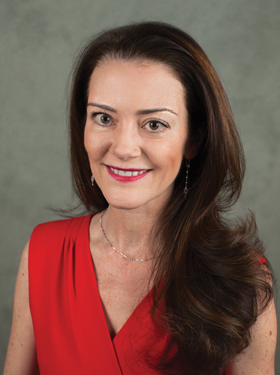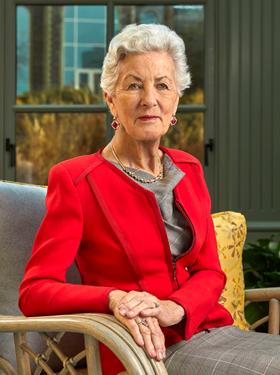The following is an edited transcript of Tom Martin’s interview with Rebecca Noble, business development executive for Alltech Crop Science.
Click below to hear the full interview:
Luther: Rebecca Noble is a business development executive for Alltech Crop Science. Welcome.
Rebecca: Thank you.
Luther: Tell me a little bit about food culture.
Rebecca: Food culture is something that we’ve talked about more in the last five to 10 years. But really, food culture is something that has existed with us since the very beginning of human civilization. Perhaps nothing is more ingrained into the concept of human survival and human livelihood than food. Because of that, it has grown with us throughout history since the first hunters and gatherers; those who survived the Ice Age were believed to be farmers. Here in the 21st century, food culture is a lot about choice and lifestyle. Food culture is something that we, as humans, depend on, emote with and cannot escape.
Luther: We’ve evolved to the point where we’re taking pictures of our food and sharing it.
Rebecca: Absolutely. That is absolutely what we’re doing.
Luther: Food is very social now.
Rebecca: Way back in the day, people carved pictures into stone to share and remember a story, so maybe it’s not even a new concept.
Luther: It might not be. Maybe there are hieroglyphics of food.
Rebecca: Exactly.
Luther: Why is food complicated, though?
Rebecca: Food culture and food have existed for millions of years. It has developed throughout our history with war, famine, economic depression and migration. A lot of that complication comes from our history.
The other part of that complication is in the monetization of food. Industrialization and capitalism joined our economy so rapidly in the past 50 to 60 years. With that, for better or worse, the intent gets complicated. The intent gets distracted. Now we have market forces — these key players — joining the conversation and interacting in new ways and disrupting the marketplace.
Luther: As we’ve evolved, we’ve come to this concept of organic food. Tell me a little bit about that.
Rebecca: We focus on consumers a lot when we talk about the organic food movement and how much they’re demanding. But the organic food movement is really something that happened from within the industry. It began most notably with British agronomist Sir Albert Howard. He was writing about organic food as opposition to the rise of scientific agriculture — to the Norman Borlaugs of science and the Haber-Bosch process of synthesizing ammonia. He was going so far as saying that artificial fertilizers would grow artificial food, which would then “nourish” artificial humans.
The idea of organic started from within the industry and then relied on key producers and growers to mobilize and take action. Then it relied on retail advocates to create the space for business — the space for capitalism, in a way — which then gave rise to the consumer movement. These are only certain consumers, I have to say, because they are classified by the middle and upper classes with rising disposable incomes; they have a bigger wallet, so we hear them a bit louder, unfortunately. These consumers will pay very high premiums — sometimes 30 to 40 percent more — for food labeled organic.
Organic, first and foremost, is a certification by — in our case in the U.S. — the U.S. Department of Agriculture. It’s a certification saying this good is organically produced. Then we take it a step further: organic is an idea. It’s an idea that has drawn from a lot of marketing; to use Jack Bobo's term, “disrupted communication.” This idea is not just about organic, but it’s about small, local producers, and it’s about healthy lifestyles; it’s emotion.
In an economic sense, organic is a premium that you can extend to the grower on one side and then charge it back to the consumer because the consumers are willing to pay for it. I think retailers will keep targeting these consumers because we see their behavior is different from a mainstream consumer. They are willing to pay 30 to 40 percent more for a good that is labeled organic — which is a certification that has a lot of cost behind it — and also labeled natural and sustainable. Natural and sustainable are labels that don’t have a regulation and don’t have a certification or even any kind of framework for definition.
We also know that these consumers who are buying organic are going to the grocery stores more often, maybe multiple times a week. When they do shop, they’re spending more money than a mainstream consumer. Retailers are going to continue to target these consumers because it’s good for business, and who can really blame them in some ways?
Luther: When we say the word “organic” and blend it with food, it really does tie into culture.
Rebecca: Absolutely.
Luther: It obviously ties into business and goes all the way back to the producer level. It’s a very complicated topic.
Rebecca: Very. I didn’t even get into the science behind it because we tend not to lead with science, as it complicates things. I think the one thing I want to say about science behind organic versus conventional farming and food is that it’s very complicated, and the messaging is very mixed and there’s no one clear answer.
Consumers who are buying organic are buying it on the basis that it’s healthier and it’s more nutritious. There are two ways to look at this: There are lower residues of pesticides on organic food, and that is a fact. However, in a place like the U.S., where the EPA has stronger regulations on the levels of pesticides allowed in our food — no matter organic or conventional — there’s no real evidence that it makes a difference in our diet. But, in countries where regulations on pesticides almost don’t exist, an organic option can be big for consumers in those developing worlds.
There’s also the nutrition side: The vitamins and minerals. For example, several studies have shown that strawberries have more vitamin C when grown organically, but a lot of studies have also shown otherwise.
I guess my point here is, it’s complicated, and there’s so much that we can step back and think about.
Luther: It sounds like when we use the word “organic,” we’re encapsulating a lot of different meanings from the consumer standpoint. Right?
Rebecca: Absolutely. Yes.
Luther: You said the word “organic” may mean antibiotic-free to one person and may mean locally grown to another.
Rebecca: Exactly. However, they’re not the same.
Luther: To someone else, it may mean it’s a traceable source.
Rebecca: Exactly. And that’s also not the same.
Luther: Visibility. Right?
Rebecca: Those are three separate ideas for one label. An organic label only actually certifies that the product wasn’t exposed to a list of substances during crop production and food-handling processes. That doesn’t mean that it was grown within 100 miles of you. For example, organic produce is delivered to the U.S. from Argentina every day. It’s still operating in the same system that conventional food is grown in.
Luther: Let’s talk about the global aspect just for a moment. In America, it seems like the availability of organic-labeled foods is increasing. They are more accessible.
Rebecca: Absolutely.
Luther: We’re starting to see them not just at Whole Foods — which we’ll talk about in a bit — but they’re also accessible in other, more mainstream chains.
Rebecca: Sure.
Luther: What about organic popularity globally? Is it growing? Is it also as important globally? Maybe more important than it is here?
Rebecca: The answer is yes. I always want to preface this with: The idea of organic and the organic movement often correlates with the development of a country and the development of a middle class with a rising disposable income.
As emerging markets enter the economy with a growing middle class, people have more choices in what they buy. As of 2017, 179 countries reported organic farming activity. I believe it is 87 or 89 countries that have a legal organic distinction available. As far as its prominence, remember that food culture is different around the world — producers and consumers look for different things.
In the U.S. and parts of northern and western Europe, the food culture is characterized as fretful. There’s a lot of anxiety around our food. Maybe we’re more apt to respond based only on anxiety and the need for nutrition and longevity than other parts of the world. In the Mediterranean and Latin American regions, food culture is characterized as social. There is still emotion around the idea of organic in these areas, but maybe it’s more centered around the social and local aspects.
In parts of Asia, it’s more about nature. We do see growth in organic markets coming from Asia as the middle class rises, and also in Latin America. We’re seeing, on average, that in the U.S., about 25 percent of consumers are purchasing organic at a premium. We’re seeing numbers in Latin America and Asia growing to 40 to 45 percent as affluence grows.
Luther: It sounds like the global market for organic is somewhat tied to the economy.
Rebecca: Economics. Absolutely. That’s the case in the U.S. as well. Organic is going to grow and will ebb and flow with the economy.
Luther: Is this a return to the past, so to speak? Before modernization, we were organic.
Rebecca: Absolutely.
Luther: We’ve modernized and brought in fertilizers and pesticides — understandably because we had to meet the rising demand. Now we’re looking at organic again. Is that a bit of a return to the past while applying today’s science?
Rebecca: I don’t think from a scientific standpoint that it’s a return to the past. I think with organics, there’s much more that we don’t know about the soil and ecosystem. We’re doing much more research into identifying different microorganisms in the ecosystem. I think from a scientific perspective, we are honoring some traditions, but I think science is going to move with organic.
I think it’s in organic’s best interest to let science move with it. It’s just a “back to basics” science, or looking at what’s inherent. From a consumer perspective, I think it’s an idea of going back to the past. It’s this idea of: This is what’s in my bones; this is what’s in my soul. Some of the first people to talk about nutrition were religious leaders. Our relationship with food is ingrained in us, even if we don’t think about it.
I think that idea and the ability to go back to basics is a luxury for some people. We should be adamant about saying that, because having food choices, in so many ways, is a luxury. I think that idea and ability to daydream about going back to basics and going back to the past is something that comes with more affluence.
Luther: The term has been coined “rising billions,” which addresses the growing populations and growing middle classes of China, India, Africa and other parts of Asia. With that growing population comes increasing strain on food production. With the rise of a middle class comes choice: Perhaps now I don’t want the same things that I used to have. With modern techniques, we’ve seen the ability to meet demand and increase yield. If we go to organic with modern science practices, are we still going to meet that demand and provide choices?
Rebecca: The easy answer to that is that we don’t know. The science is muddy. It’s very clear that conventionally farmed wheat, corn and soy have much higher yields than organically farmed wheat, corn and soy. There are other organic vegetables and fruits that may have better yields when farmed organically, but the science is so muddy. I don’t think we know. More importantly, if we are going to be farming organically, can we make food affordable?
Something I should have pointed out earlier is that organic agriculture only makes up 1.1 percent of total U.S. cropland. That means there’s a question of scalability in front of us. It’s a big question, and the science is not clear. If anything, the science overwhelmingly states that it’s impossible. Organic agriculture cannot displace conventionally grown food and the need for cheaper food.
Luther: You brought up price and the fact that 1.1 percent of farmland is currently designated for organic food. There’s still a lot of traditional food being produced. But Whole Foods came in and disrupted the marketplace. Can you give us a little insight into that?
Rebecca: Absolutely. When looking at the organic movement, Whole Foods was one of the first retail advocates, and it has been the most outspoken and transparent company within the movement. It’s grown steadily for over a decade, now reaching annual sales over $15 billion. Whole Foods set out to create the infrastructure and supply chain around organics, natural and local food.
Whole Foods opened the door for mainstream competition. We look at Costco, which reported just two years ago that it was the leader in sales of organic produce, selling over $4 billion in organic produce in 2015. It’s now working with its growers to purchase organic land for it because it simply cannot meet the demand of its consumers.
Kroger is selling $11 billion in natural and organic products — that’s 10 percent of its business — in just five years. It’s been able to reach 70 percent of Whole Foods’ capacity in just five years. We also look at Walmart, which has long been trying to enter the organics game and is on a mission to provide its customers — its mainstream customers — organic products priced 30 to 40 percent below comparable items.
Mainstream competition has really heightened. Whole Foods has made organic a mainstay within the industry. Organic is now 10 percent of Kroger and Costco business. That’s only going to grow because those margins are so much higher.
Luther: It’s great to see it has expanded and that the price point is coming down, potentially making organic food more accessible. Has the table turned a little bit for organic food at this point? Has it gone from being a niche part of the economy to a more accessible portion of the economy?
Rebecca: Absolutely. I believe so. When we talk about consumers who purchase organic, a lot of times we refer to numbers. For example, 80 percent of consumers are purchasing organic either a couple times a week, or every time they go. I think what we have are consumers — mainstream consumers who are searching for a lower price point — creeping up into this periphery category where they are looking at organic prices and making those purchases, but it’s not going to be their entire basket.
Luther: How important is age in determining whether I buy organic or I don’t buy organic?
Rebecca: Age is perhaps the factor that we’re able to study and that we’ve seen as a significant factor when looking at consumer insights. The popularity of organics, natural food and local food are more concentrated in younger generations, particularly with millennials and Generation Z — the generation of 20-year-olds and younger who are going off to college and making independent food choices for the first time. They are more likely to shop at specialty retailers that are more devoted to the natural, organic lifestyle.
Luther: What does the future hold for organic food?
Rebecca: We have to remember that organic is a label; it’s a certification. It means that the product was not grown with this list of substances. It’s not so much about what the future holds for organic food, but it’s about the next premium. What is that next action that production consumers and proactive consumers can take, either through organic or conventional growers? Is it a label or a third-party certification regarding their energy use; their water efficiency; their labor practices; how they treat biodiversity within their land? That’s really the next frontier. It’s not so much organics. Organics are pretty much here to stay. We have a consumer base that will pay that premium.
The question is: What are retailers going to be looking to capitalize on next? Maybe looking to conventional growers? What changes are conventional growers going to have to make to fulfill that demand? It’s less about the organic label and more about the next demand on agricultural production, whether it’s organic or conventional growers. We know that consumers, proactive retailers and producers are forcing change within the industry. What’s next is more about how producers are sustainable and how you can communicate that effectively to a consumer.
Luther: Last question: What is the favorite part of your job?
Rebecca: I think, without a doubt, the favorite part of my job is being able to be in the food industry and to have discussions about food.
We started off the podcast today talking about food culture, and that’s something that I absolutely feel: Food is not just about feeding myself. It’s about emoting and showing support, love and security for people all over the world. It’s about having an absolute passion for food and how it’s grown, being able to better understand that and then, hopefully, being able to communicate that to other people.
At our conference, Jack Bobo said that never have consumers cared more but known less about how their food was produced. Being able to understand that, meet the people who produce our food and who are responsible for meeting our needs is a real honor. It’s my absolute favorite part of my job.
Luther: Rebecca Noble, business development executive for Alltech Crop Science. Thank you for joining us.
Rebecca: Thank you so much.
Rebecca Noble spoke at ONE: The Alltech Ideas Conference (ONE17). To hear more talks from the conference, sign up for the Alltech Idea Lab.





























